 W
WThis is a list of the bird species recorded in Iceland. The avifauna of Iceland included a total of 378 confirmed species as of April 2016 according to the Icelandic Birding Pages (IBP). An additional 22 species and one replacement had been recorded by eBird users by August 2019. Of the 400 species listed here, 319 are accidental. The entire populations of two species have resulted from introductions by humans, and a few other species have individuals of both natural and human-assisted origin. One species on the list is extinct.
 W
WHallormsstaður National Forest is located in Fljótsdalur east Iceland, about 25 kilometers inland from the town of Egilsstaðir. It is one of the larger forests in Iceland, covering 740 hectares (ha), and includes the only village in Iceland that is located in a forest. The forest is a recreation area in a varied landscape. There are over 40 km of marked trails and footpaths as well as an arboretum, two camp-sites, picnic areas, a hotel, and boat and horse rentals.
 W
WThe great auk is a species of flightless alcid that became extinct in the mid-19th century. It was the only modern species in the genus Pinguinus. It is not closely related to the birds now known as penguins, which were discovered later and so named by sailors because of their physical resemblance to the great auk.
 W
WThe snow bunting is a passerine bird in the family Calcariidae. It is an Arctic specialist, with a circumpolar Arctic breeding range throughout the northern hemisphere. There are small isolated populations on a few high mountain tops south of the Arctic region, including the Cairngorms in central Scotland and the Saint Elias Mountains on the southern Alaska-Yukon border, as well as the Cape Breton Highlands. The snow bunting is the most northerly recorded passerine in the world.
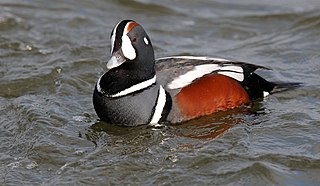 W
WThe harlequin duck is a small sea duck. It takes its name from Harlequin, a colourfully dressed character in Commedia dell'arte. The species name comes from the Latin word "histrio", meaning "actor". In North America it is also known as lords and ladies. Other names include painted duck, totem pole duck, rock duck, glacier duck, mountain duck, white-eyed diver, squeaker and blue streak.
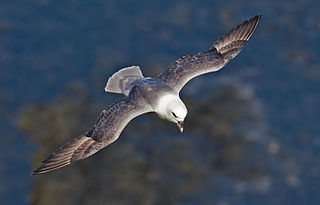 W
WThe northern fulmar, fulmar, or Arctic fulmar is a highly abundant sea bird found primarily in subarctic regions of the North Atlantic and North Pacific oceans. There has been one confirmed sighting in the Southern Hemisphere, with a single bird seen south of New Zealand. Fulmars come in one of two color morphs: a light one, with white head and body and gray wings and tail, and a dark one which is uniformly gray. Though similar in appearance to gulls, fulmars are in fact members of the family Procellariidae, which include petrels and shearwaters.
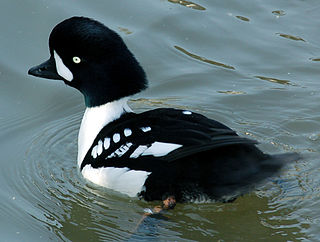 W
WBarrow's goldeneye is a medium-sized sea duck of the genus Bucephala, the goldeneyes. This bird was named after Sir John Barrow. The genus name is derived from Ancient Greek boukephalos, "bullheaded", from bous, "bull " and kephale, "head", a reference to the bulbous head shape of the bufflehead. The species name islandica means Iceland.
 W
WThe barnacle goose belongs to the genus Branta of black geese, which contains species with largely black plumage, distinguishing them from the grey Anser species. Despite its superficial similarity to the brant goose, genetic analysis has shown it is an eastern derivative of the cackling goose lineage.
 W
WThe pink-footed goose is a goose which breeds in eastern Greenland, Iceland and Svalbard. It is migratory, wintering in northwest Europe, especially Ireland, Great Britain, the Netherlands, and western Denmark. The name is often abbreviated in colloquial usage to "pinkfoot". Anser is the Latin for "goose", and brachyrhynchus comes from the ancient Greek brachus "short" and rhunchos "bill".
 W
WThe black guillemot or tystie is a medium-sized seabird of the alcid family, Alcidae, native throughout northern Atlantic coasts and eastern North American coasts. It is resident in much of its range, but large populations from the high arctic migrate southwards in winter. The bird can be seen in and around its breeding habitat of rocky shores, cliffs and islands in single or smalls groups of pairs. They feed mainly by diving towards the sea floor feeding on fish, crustaceans or other benthic invertebrates. They are listed on the IUCN red list as a species of least concern.
 W
WThe great black-backed gull, mistakenly called greater black-backed gull by some, is the largest member of the gull family. A very aggressive hunter, pirate and scavenger, it breeds on the European and North American coasts and islands of the North Atlantic and is fairly sedentary, though some move farther south or inland to large lakes or reservoirs. The adult great black-backed gull has a white head, neck and underparts, dark grey wings and back, pink legs and yellow bill.
 W
WThe parasitic jaeger, also known as the Arctic skua, Arctic jaeger or parasitic skua, is a seabird in the skua family Stercorariidae. The word "jaeger" is derived from the German word Jäger, meaning "hunter". The English "skua" comes from the Faroese name skúgvur [ˈskɪkvʊər] for the great skua, with the island of Skúvoy known for its colony of that bird. The general Faroese term for skuas is kjógvi [ˈtʃɛkvə]. The genus name Stercorarius is Latin and means "of dung"; the food disgorged by other birds when pursued by skuas was once thought to be excrement. The specific parasiticus is from Latin and means "parasitic".
 W
WThe black-legged kittiwake is a seabird species in the gull family Laridae.
 W
WThe common loon or great northern diver is a large member of the loon, or diver, family of birds. Breeding adults have a plumage that includes a broad black head and neck with a greenish, purplish, or bluish sheen, blackish or blackish-grey upperparts, and pure white underparts except some black on the undertail coverts and vent. Non-breeding adults are brownish with a dark neck and head marked with dark grey-brown. Their upperparts are dark brownish-grey with an unclear pattern of squares on the shoulders, and the underparts, lower face, chin, and throat are whitish. The sexes look alike, though males are significantly heavier than females. During the breeding season, loons live on lakes and other waterways in Canada; the northern United States ; and southern parts of Greenland and Iceland. Small numbers breed on Svalbard and sporadically elsewhere in Arctic Eurasia. Common loons winter on both coasts of the US as far south as Mexico, and on the Atlantic coast of Europe.
 W
WThe red-breasted merganser is a diving duck, one of the sawbills. The genus name is a Latin word used by Pliny and other Roman authors to refer to an unspecified waterbird, and serrator is a sawyer from Latin serra, "saw". The red-breasted merganser was one of the many bird species originally described by Carl Linnaeus in his landmark 1758 10th edition of Systema Naturae, where it was given the binomial name Mergus serrator.
 W
WThe common murre or common guillemot is a large auk. It is also known as the thin-billed murre in North America. It has a circumpolar distribution, occurring in low-Arctic and boreal waters in the North Atlantic and North Pacific. It spends most of its time at sea, only coming to land to breed on rocky cliff shores or islands.
 W
WThe European storm petrel, British storm petrel, or just storm petrel is a seabird in the northern storm petrel family, Hydrobatidae. It is the only member of the genus Hydrobates. The small, square-tailed bird is entirely black except for a broad, white rump and a white band on the under wings, and it has a fluttering, bat-like flight. The large majority of the population breeds on islands off the coasts of Europe, with the greatest numbers in the Faroe Islands, United Kingdom, Ireland, and Iceland. The Mediterranean population is a separate subspecies, but is inseparable at sea from its Atlantic relatives; its strongholds are Filfla Island (Malta), Sicily, and the Balearic Islands.
 W
WLeach's storm petrel or Leach's petrel is a small seabird of the tubenose order. It is named after the British zoologist William Elford Leach. The scientific name is derived from Ancient Greek. Oceanodroma is from okeanos, "ocean" and dromos, "runner", and leucorhoa is from leukos, "white" and orrhos, "rump".
 W
WThe red phalarope or grey phalarope is a small wader. This phalarope breeds in the Arctic regions of North America and Eurasia. It is migratory, and, unusually for a wader, migrating mainly on oceanic routes and wintering at sea on tropical oceans.
 W
WThe European golden plover, also known as the Eurasian golden plover or just the golden plover within Europe, is a largish plover. This species is similar to two other golden plovers: the American golden plover, Pluvialis dominica, and Pacific golden plover, Pluvialis fulva, which are both smaller, slimmer and relatively longer-legged than European golden plover, and both have grey rather than white axillary feathers.
 W
WThe common ringed plover or ringed plover is a small plover that breeds in Arctic Eurasia. The genus name Charadrius is a Late Latin word for a yellowish bird mentioned in the fourth-century Vulgate. It derives from Ancient Greek kharadrios a bird found in ravines and river valleys. The specific hiaticula is Latin and has a similar meaning to the Greek term, coming from hiatus, "cleft" and -cola, "dweller".
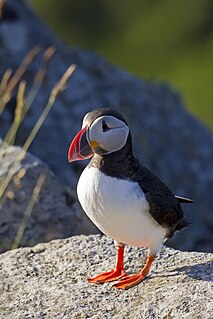 W
WThe Atlantic puffin, also known as the common puffin, is a species of seabird in the auk family. It is the only puffin native to the Atlantic Ocean; two related species, the tufted puffin and the horned puffin, are found in the northeastern Pacific. The Atlantic puffin breeds in Iceland, Norway, Greenland, Newfoundland, Nova Scotia and the Faroe Islands, and as far south as Maine in the west and parts of Great Britain in the east. The Atlantic Puffin is most commonly found on the Westman Islands, Iceland. Although it has a large population and a wide range, the species has declined rapidly, at least in parts of its range, resulting in it being rated as vulnerable by the IUCN. On land, it has the typical upright stance of an auk. At sea, it swims on the surface and feeds mainly on small fish, which it catches by diving under water, using its wings for propulsion.
 W
WThe razorbill or lesser auk is a colonial seabird in the monotypic genus Alca of the family Alcidae, the auks. It is the closest living relative of the extinct great auk. Wild populations live in the subarctic waters of the Atlantic Ocean.
 W
WThe purple sandpiper is a small shorebird. The genus name is from Ancient Greek kalidris or skalidris, a term used by Aristotle for some grey-coloured waterside birds. The specific maritima is from Latin and means "of the sea", from mare, "sea".
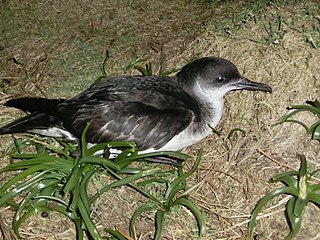 W
WThe Manx shearwater is a medium-sized shearwater in the seabird family Procellariidae. The scientific name of this species records a name shift: Manx shearwaters were called Manks puffins in the 17th century. Puffin is an Anglo-Norman word for the cured carcasses of nestling shearwaters. The Atlantic puffin acquired the name much later, possibly because of its similar nesting habits.
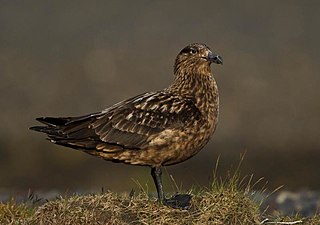 W
WThe great skua is a large seabird in the skua family Stercorariidae. It is roughly the size of a herring gull. It mainly eats fish which is taken from the surface of the sea or from other birds.